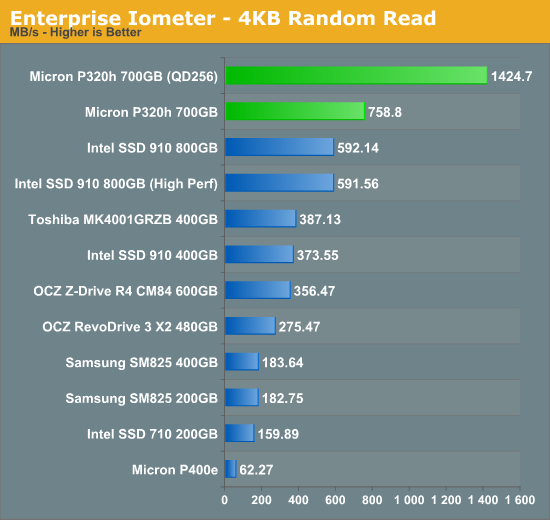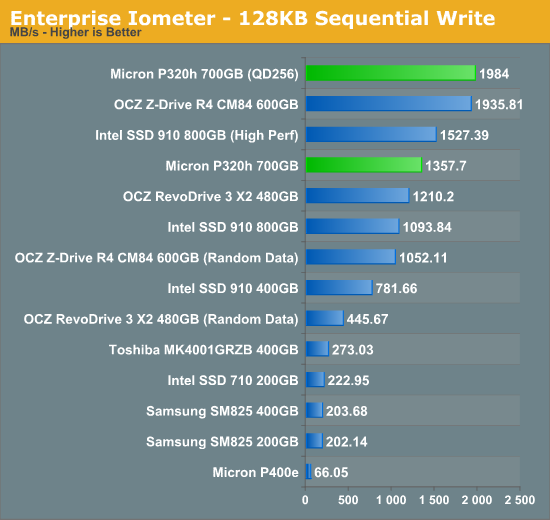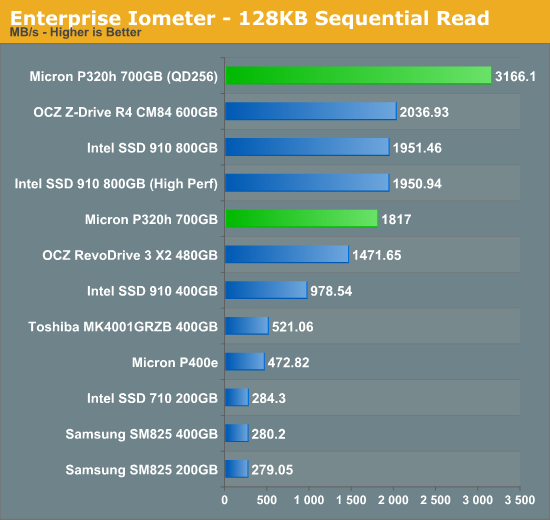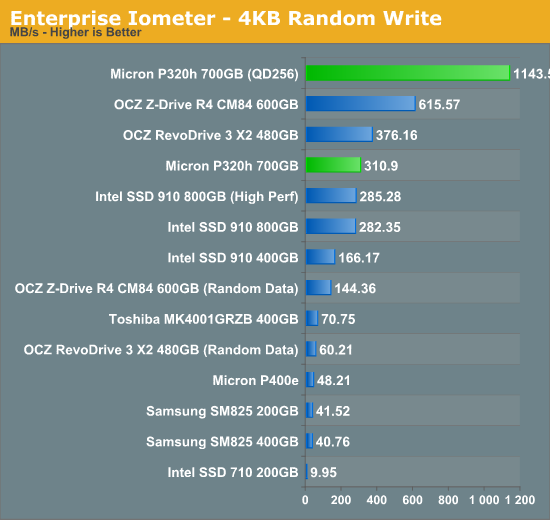Micron P320h PCIe SSD (700GB) Review
by Anand Lal Shimpi on October 15, 2012 3:00 AM ESTRandom Read/Write Speed
The four corners of SSD performance are as follows: random read, random write, sequential read and sequential write speed. Random accesses are generally small in size, while sequential accesses tend to be larger and thus we have the four Iometer tests we use in all of our reviews. For our enterprise suite we make a few changes to our usual tests.
Our first test writes 4KB in a completely random pattern over all LBAs on the drive (compared to an 8GB address space in our desktop reviews). We perform 32 concurrent IOs (compared to 3) and run the test until the drive being tested reaches its steady state. The results reported are in average MB/s over the entire time. We use both standard pseudo randomly generated data for each write as well as fully random data to show you both the maximum and minimum performance offered by SandForce based drives in these tests. The average performance of SF drives will likely be somewhere in between the two values for each drive you see in the graphs. For an understanding of why this matters, read our original SandForce article.
Excluding the two SandForce data points using highly compressible data, the P320h is the new king here. At least in the 700GB configuration the P320h is able to offer better steady state 4KB random write performance than Intel's SSD 910. The drive also delivers over 6x the performance of Micron's 2.5" P400e.

Random read performance is an even more impressive showing for the P320h at 758MB/s. This is truly the benefit of having 32 NAND concurrently accessible channels, given a heavy workload there's more than enough data to parallelize and stripe across all channels.
Sequential Read/Write Speed
Similar to our other Enterprise Iometer tests, queue depths are much higher in our sequential benchmarks. To measure sequential performance I ran a 1 minute long 128KB sequential test over the entire span of the drive at a queue depth of 32. The results reported are in average MB/s over the entire test length.

Peak sequential write performance is slightly behind Intel's SSD 910 operating in its 38W high performance mode, but still very competitive. At 1357MB/s workloads that need to move large blocks of data will enjoy great performance on the P320h. Micron claims much higher sequential read/write numbers under Linux at 256 concurrent IOs.

Sequential read performance is also very strong at 1817MB/s. The 910 as well as OCZ's Z-Drive R4 manage better performance here.











57 Comments
View All Comments
zlyles - Wednesday, October 17, 2012 - link
Because it wasn't meant to be... it makes me laugh to see how many people think Micron, Intel, and OCZ are developing these PCI-e SSD's for the consumer market. This is an enterprise class drive, and as such is not meant to be a bootable drive unless you are booting VM's on a hypervisor.Cloakstar - Monday, October 15, 2012 - link
I get the impression these tests did not stress this drive.Compare the relationship between disk busy time and average QD for the test tp the other drives. The higher the QD, the lower the relative disk busy time compared to the competition.
-In IOMeter tests with QD32, no disk busy time is recorded, but the drive is in a solid lead for random noncompressible data throughtput.
-The poorest numbers for this drive happen at lowest QD.
-The highest listed QD for any test, here is 32.
-"Micron claims much higher sequential read/write numbers under Linux at 256 concurrent IOs."
apmon2 - Tuesday, October 16, 2012 - link
"I get the impression these tests did not stress this drive."Yes, that seems to be the case. thessdreview.com have what looks like a really nice review [1] including tests of a QD up to 512. There one can see that it achieves only about a 1/3 of its peak performance with a QD of 32. Not till a QD of 128 or even 256 does it achieve its full potential. Then however it seems to perform truly amazing, and is able to completely saturate the 8x PCIe 2.1 bus with 4k random reads! It supposedly can sustain 3.3GB/s of 4kb random reads.
Even at small 512B read requests it can, according to them, still achieve on the order of 600Mb/s, achieving well in access of 1.5 million IOps. Even then the limiting factor was the CPU, not the device, despite using a core i7 that was overclocked to 4.9 GHz.
So if those numbers are true, Anand didn't even come close to stressing this SSD to its limit (or intended purpose).
[1] http://thessdreview.com/our-reviews/micron-p320h-h...
bthanos - Monday, October 15, 2012 - link
Hi Anand,Nice Article, however the Micron p320h is not a NVME interface drive. Its PCIe Gen 2 , AHCI.
Jaybus - Tuesday, October 16, 2012 - link
As stated in the article, the drive is using IDT's 32-channel PCIe gen 3 x8 controller, but operating it in gen 2 mode. Since x8 gen 2 is sufficiently faster than the drive is capable of, it is a good choice, as it allows compatibility for use in systems without gen 3 slots. IDT claims full compliance with the NVM Express standard. See http://www.idt.com/products/interface-connectivity... for controller specs.Looks like a NVM Express drive to me. Why would you say it is not?
bthanos - Tuesday, October 16, 2012 - link
Because the IDT controllers released at Flash Memory Summit are new SOCs, the Micron p320h drive is using a previous jointly developed SOC which is not NVME. See comment from Anand..colonelpepper - Monday, October 15, 2012 - link
On the issue of durability or whatever you want to call it..."50 petabytes of writes" is totally meaningless marketing intellect abuse.
It only takes on a meaning if you were to fill up the entire drive at once and then erase it and then write to the entire volume again etc until you reached 50 petabytes of writes.
Show me a hard drive that is ever used like that and I'll donate the pot of gold I've got stashed out back to your favorite charity.
DataC - Tuesday, October 16, 2012 - link
Colonel Pepper, at Micron we spec TBW or total bytes written, but it’s closely related to another standard you’ll see in the enterprise industry, “X drive fills per day for 5 years.” The two specs are simply different ways to express the same number. The spec tracks the amount of bytes you can write to the SSD before the NAND exceeds its wear life and reverts to a write-protect (read only) mode. It includes any and every write ever made to the drive, not just the full drive fills and erases you’ve described.rrohbeck - Monday, October 15, 2012 - link
What I don't understand though is why SSD controllers don't have PHYs that can talk PCIe as well as SATA/SAS. Then manufacturers could leverage the high volume/high performance SATA/SAS designs for PCIe too. The firmware would probably be even simpler.DanNeely - Monday, October 15, 2012 - link
Because it would be adding additional complexity, die size, and cost, to mass produced consumer parts with very thin margins. All of which are good ways to go out of business.